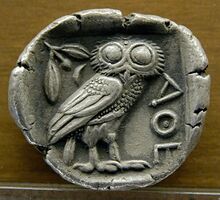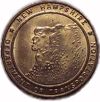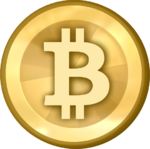Coin
A coin is a small, flat, round object with a profile of a monarch, President,[1] or despot stamped onto it. Coins are used primarily as a medium for releasing a shopping trolley, dropping into a busker's cap, or pumping into arcade games. They also enable the washing of apparel. They are standardized in weight, produced in large quantities at a mint, and indeed look a lot like mints.[2] They are most often issued by a government or occasionally a one-armed bandit.
Coins are usually metal or alloy, but sometimes made of synthetic materials. Coins made of valuable metal are stored in large quantities as bullion coins, just so older, traditional, computer-illiterate bank robbers can still use balaclavas and swag bags instead of hacking. This lets banks avoid age discrimination charges.
History
The first coins were developed independently in Iron Age Anatolia and Archaic Greece, as they were more convenient to trade for a pint of milk and the morning Telegraph than a wallet full of cows. Coins spread rapidly throughout Greece and Persia, though they were then Balkanized.
Standardized Roman currency was used throughout the Roman Empire. Roman gold and silver coins continued in use into the Middle Ages, though poor lighting made it difficult to see the value unless held at arm's length.
Originally, medieval serfs were gotten to use coins because they contained valuable metal, whereas a wallet full of cows was as bulky as ever. This left leaders no option for plunder other than intentionally debasing their coins. Although the coins still contained valuable metal, the value was gradually shaved away. Oddly, the citizens eventually caught up to the trick and started demanding more coins for the same pint of milk. This resulted in the creation of “market uncertainty,” and monetary policy was removed from buyers and sellers and handed to the business journalist.
It was natural that the first paper money arose in China — which already had paper lanterns, rockets, hats, toy boats, and airplanes. In contrast, France had papier maché, but never managed to adapt it into a workable currency, as it remained harder than a coin to throw into a toll bucket. Early paper money was introduced in Europe in the later Middle Ages, but coins continued to have the value of their gold or silver, while peasants were not moved by the intrinsic value of paper and ink.
After the American Revolution, the United States issued coins made almost entirely from sugar. These were the Oreos. Given the American tendency toward free competition, it was not long before the Hydrox sprang up to challenge it. Every spring during their fund drive, Girl Scouts overwhelm American markets with dozens of varieties of sugar-based coinage. Sugar coinage was finally ended by the U.S. Constitution. (Art. I, § 10, "No state shall...make any thing but gold and silver coin a tender....") Unfortunately, it had nothing to say about Gummy Bears.
In the 19th century, hands across the Atlantic were sufficiently accustomed to exchanging coins that their leaders began to withdraw coins that were worth something, in favor of coins that were not. The United States developed the innovation of coins whose surfaces seemed to be worth something though the insides were not. Americans happily accepted this new "silver," as the technique reminded them of political rhetoric, and the result resembled the tasty peanut butter sandwich. The British were induced to accept coins of no real value by making them clunky and heavy, and giving them historical names and shapes. Throughout Latin America, coins have emerged where the center appears valuable but the edges do not, or vice versa. People accept these coins not on their intrinsic value nor the credibility of a promise, but simply because they look different.
Around this time, monetary policy was snatched back from the business journalist and given directly to central bankers. These policymakers, after years of study at university, publish papers, stroke beards, and practice the automated and planned shaving of the edges of coins. The American Federal Reserve is the highly imitated model. Central bankers seem to realize that their day-at-the-office will eventually raise the price of everything, but believe that this will spur universal productivity, provided they manage it so that there is just a little of it and it does not get out of hand. When the economy has recovered, they can simply put the shavings back into the coins, so no harm has been done (unless other pressing national needs arise in the meantime).
Uses
Coins are ideal for persons wanting to carry around money in a form heavier than paper money, as the typical value of coins in circulation is less than the lowest-value note. Coins are also advantageous for people who enjoy making noise as they walk, or who think a perpetual "jingle" in their pocket will dissuade adversaries from hanging a bell around their necks. Coins are vital for those with summer cabins with fuse boxes, as a small copper coin can obviate replacement fuses that probably aren't still being manufactured anyway.
The predominant use of coins is in flipping, whether to settle a bet or decide who is going into the neighbor's yard to clean up after the dog. This use is facilitated by the fact that the design on the front (or converse) is always different from that on the back (or contrapositive) except in nations that are very cheap, or whose despot insists that his visage be on both sides. This latter is no longer practiced in the G10 countries, where any leader understands that the less the constituents see his face, the more likely they are to re-elect him.
To flip a coin, one of the adversaries picks "heads" and the other picks "tails." Whoever predicts which side will face upward after the flip gets to start the second round, of arguing about which side looks like it should really be the "heads." Flipping a coin is a much more decisive gesture than flipping a banknote.
The coin flip is the feature moment of most sporting events. The team captain who correctly predicts the result of the flip gets to cheat first, while the other captain is only guaranteed a prime slot in which to cheat at the start of the second half. The New England Patriots always "defer" and let the opponent have the first chance to cheat, which is to say that Coach Belichick even cheats at the coin flip.
An exception is baseball; while there are now dozens of clocks, not to mention Instant Replay cameras, there are still no coins in the game. In lieu of a coin flip, the home team magnanimously gives the visitors first advantage, reserving an extra turn for itself when it matters the most. Fans are not disappointed by the lack of a coin flip, as there are still dozens of reasons for managers to stop the game and argue for five minutes.
Coins and inflation
Usually the monetary value of a coin in circulation is worth less than the lowest-value banknote. This is because a much lengthier promise (or at least a scolding that you are legally required to accept it) can be written on a banknote than stamped on a coin.
Over time, the face value of circulation coins has occasionally been lower than the value of the metal they contain — for example, due to inflation — while almost always being worth more than a piece of paper. As currencies plummet toward worthlessness, a half kilogram of copper in the pocket may end up the only tender worth anything at all.
If the value of coins drops well under that of their metal, the issuing authority may withdraw them from circulation before everyone heads for the scrapyard or starts hoarding them. Issuing authorities may change the material to something that is of less value, such as Vegemite or rock. This replaces the race to spend them with a race to hoard the old ones, and an obsession by customers and shopkeepers to check the date on every penny so as to salt the old ones away. This phenomenon is called Gresham's Law. Gresham is likely to have a bonanza of valuable old coins in a back room, though his heirs have not yet finished shoveling away the cat feces in the parlor in order to reach the door to it.
Bullion
Exceptions to the rule of face value being higher than content value also occur for some bullion coins, typically made of silver or gold. They are intended for collectors, investors in precious metals, and misers. The following are examples of modern collector/investor coins:
- The British sovereign minted by the United Kingdom
- The Gold Eagle minted by the United States
- The Gold Maple Leaf minted by Canada, and
- The Krugerrand, minted by South Africa.
While most of these coins bear nominal, though purely symbolic, face values, the Krugerrand does not. Anyone stupid enough to keep gold in felt-lined trays in Cape Town is going to get robbed.
Collectibles
Another exception is collectible coins, typically made of zinc, copper, or steel. They are intended for grifters, because they look nondescript, but I know that few were ever minted and you do not. The coin collector accumulates these coins, not because he can spend them, but because he hopes to pawn them off on an even more desperate collector at some future date. This would be the apocryphal Greater Fool.
The collector also relies on the passage of time, and the fact that a stronger force than the packrat instinct, in which people hope to save money by retaining everything and renting a truck to take it to their rented Self Storage unit, is the periodic cleaning fit, in which an owner channels rage by discarding everything associated with memories that are a bit negative, or has a spouse who thinks the drawers have grown untidy.
Basement-dwelling offspring, especially those with a cocaine habit, also tend to ravage stores of collectibles. The coin collector believes these forces will make his own coins ever more valuable, and that he can keep his own children from raiding his collection.
Ten Peso Coin
The golden $10 coin minted by Mexico is prized not because of the value of its metal nor because anyone cares about its rarity, but solely that it represents ten pesos that will actually buy something, and will continue to do so no matter how desperate the ruling party becomes in the run-up to the next election.
Commemorative sets
In the United States, whose citizens will now accept anything if it is sufficiently shiny, government has begun changing the design of coinage on a whim. The most notorious example is the set of "state quarter-dollars," in which no one learns all fifty but just resolves to accept anything that is about the right size and has ridges on the edge. Again, if it turns out to be an Oreo, there is no great harm done.
School children compete to design the contrapositive of their state's quarter. Happily, this keeps them out of the legislature whining to legislators to pass a law enshrining their choice of Official State Snack Food.
In theory, each state selects a design that reflects its unique heritage. Unfortunately, in Nevada, bordellos are privately owned and virtually all declined to be honored on the Nevada quarter. New Hampshire agreed to feature the "Old Man of the Mountain" rock formation (which could not say no), and came to consensus within barely a decade of the avalanche that demolished it.
Famous coins in history
Poison coin
On his pathbreaking U2 flight above the Soviet Union to see what he could see (and take infrared photographs of it), American spy Gary Powers carried a dollar coin with shellfish toxin embedded in the grooves. This was essentially a CIA-issue suicide pill in case of his capture by the Soviets. Unfortunately, during a brief dalliance with his comely co-pilot, he spent this option in the condom machine in the lavatory. He survived an attempt to ram, but his multiple missions were all interruptus by a Soviet surface-to-air missile. He was captured by the Soviets and had to make up a convincing excuse in captivity for the strange stains on his pressure suit.
Bitcoin
The bitcoin is not a coin. It does not represent money at all, but the triumph of abstract computer science over money. The only thing it has in common with money is that anyone who comes into possession of one hopes to find a Greater Fool who will accept it in exchange for goods or services, and preferably pay the tax on bartering transactions for him or her.
A metal disc that says it is a bitcoin is certainly not a bitcoin, as metal discs don't have no stinkin' Block Chains.
Most coins strive to make the user believe that there is value behind them. The coin's sides state some denomination. A bitcoin coin does none of the above. It merely signifies that the holder is part of a community that rejects government fiat money. When such a community member confronts a mugger and needs emergency assistance, he telephones a Linear Algebra professor.
References
- ↑ Or, as a result of the administration of Barack Obama, a rapper or community activist.
- ↑ Coins go down nowhere near as easily as mints, however, and good luck trying to file suit if you chip your teeth on a coin.
See also
| Featured version: 12 December 2016 | |
| This article has been featured on the main page. — You can vote for or nominate your favourite articles at Uncyclopedia:VFH. | |








